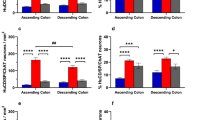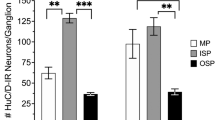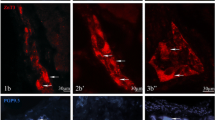Abstract
Neuropeptide Y (NPY) performs varied functions in the nervous system, including the regulation of vascular tone and gastrointestinal secretion. Specifically, it exerts a direct inhibitory effect on intestinal motility and secretion. Colocalization of NPY with choline acetyltransferase (ChAT), the enzyme catalyzing acetylcholine synthesis, as well as neuronal NO synthase (nNOS), vasoactive intestinal peptide (VIP) and calcium-binding protein calbindin (CB), was studied in enteric neurons of the submucosal plexus of the rat small intestine at different ages (from the moment of birth until old age) using double immunolabeling and fluorescence microscopy. From the moment of birth, all NPY-ergic neurons colocalize ChAT, while most of them also contain VIP and CB. In aged rats, the percentage of NPY-ergic neurons colocalizing CB, VIP and ChAT decreases. Both in juvenile (since birth until 20 days of age) and aged rats, NPY-ergic neurons were found to express nNOS. Thus, at early stages of ontogeny and in senescence, the rat enteric metasympathetic NPY-ergic submucosal neurons contain a wider range of neurotransmitters compared to adult animals.





Similar content being viewed by others
REFERENCES
Furness JB (2006) The enteric nervous system. Blackwell Publishing, Oxford.
Masliukov PM, Budnik AF, Nozdrachev AD (2017) Neurochemical Features of Metasympathetic System Ganglia in the Course of Ontogenesis. Adv Gerontol 7(4):281-289. https://doi.org/10.1134/S2079057017040087
Furness JB, Stebbing MJ (2018) The first brain: Species comparisons and evolutionary implications for the enteric and central nervous systems. Neurogastroenterol Motil 30(2):e13234. https://doi.org/10.1111/nmo.13234
Cox HM (2007) Neuropeptide Y receptors; antisecretory control of intestinal epithelial function. Auton Neurosci 133(1):76–85. https://doi.org/10.1016/j.autneu.2006.10.005
Nozdrachev AD, Masliukov PM (2011) Neuropeptide Y and autonomic nervous system. Zh Evol Biokhim Fiziol 47:105-112. https://doi.org/10.1134/S0022093011020010
Rytel L, Szymanska K, Gonkowski I, Wojtkiewicz J (2018) Neurochemical characterization of intramural nerve fibres in the porcine oesophagus. Anat Histol Embryol 47(6):517-526. https://doi.org/10.1111/ahe.12391
Mongardi Fantaguzzi C, Thacker M, Chiocchetti R, Furness JB (2009) Identification of neuron types in the submucosal ganglia of the mouse ileum. Cell Tissue Res 336(2):179-189. https://doi.org/10.1007/s00441-009-0773-2
Budnik AF, Aryaeva D, Vyshnyakova P, Masliukov PM (2020) Age related changes of neuropeptide Y-ergic system in the rat duodenum. Neuropeptides 80:101982. https://doi.org/10.1016/j.npep.2019.101982
Mann PT, Furness JB, Southwell BR (1999) Choline acetyltransferase immunoreactivity of putative intrinsic primary afferent neurons in the rat ileum. Cell Tissue Res 297:241–248. https://doi.org/10.1007/s004410051352
Kolos EA, Korzhevskii DA (2016) Heterogeneous choline acetyltransferase staining in cholinergic neurons. Neurochem J 10(1):47-52 (In Russ).
Jia C, Hegg CC (2015) Effect of IP3R3 and NPY on age-related declines in olfactory stem cell proliferation. Neurobiol Aging 36(2):1045-1056. https://doi.org/10.1016/j.neurobiolaging.2014.11.007
Saraf R, Mahmood F, Amir R, Matyal R (2016) Neuropeptide Y is an angiogenic factor in cardiovascular regeneration. Eur J Pharmacol 776:64-70. https://doi.org/10.1016/j.ejphar.2016.02.033
Tan CMJ, Green P, Tapoulal N, Lewandowski AJ, Leeson P, Herring N (2018) The Role of Neuropeptide Y in Cardiovascular Health and Disease. Front Physiol 9:1281. https://doi.org/10.3389/fphys.2018.01281
Foong JP (2016) Postnatal Development of the Mouse Enteric Nervous System. Adv Exp Med Biol 891:135-143. https://doi.org/10.1007/978-3-319-27592-5_13
Masliukov PM, Moiseev K, Budnik AF, Nozdrachev AD, Timmermans JP (2017) Development of calbindin- and calretinin-immunopositive neurons in the enteric ganglia of rats. Cell Mol Neurobiol 37(7):1257–1267. https://doi.org/10.1007/s10571-016-0457-x
Tough IR, Forbes S, Tolhurst R, Ellis M, Herzog H, Bornstein JC, Cox HM (2011) Endogenous peptide YY and neuropeptide Y inhibit colonic ion transport, contractility and transit differentially via Y1 and Y2 receptors. Br J Pharmacol 164:471–484. https://doi.org/10.1111/j.1476-5381.2011.01401.x
Chandrasekharan B, Nezami BG, Srinivasan S (2013) Emerging neuropeptide targets in inflammation: NPY and VIP. Am J Physiol Gastrointest Liver Physiol 304(11):G949-G957. https://doi.org/10.1152/ajpgi.00493.2012
Wyss-Coray T (2016) Ageing, neurodegeneration and brain rejuvenation. Nature 539(7628):180-186. https://doi.org/10.1038/nature20411
Young HM, Ciampoli D (1998) Transient expression of neuronal nitric oxide synthase by neurons of the submucous plexus of the mouse small intestine. Cell Tissue Res 291:395–401. https://doi.org/10.1007/s004410051009
Bergner AJ, Stamp LA, Gonsalvez DG, Allison MB, Olson DP, Myers MG Jr, Anderson CR, Young HM (2014) Birthdating of myenteric neuron subtypes in the small intestine of the mouse. J Comp Neurol 522(3):514-527. https://doi.org/10.1002/cne.23423
Maslyukov PM, Shilkin VV, Timmermans JP (2006) Immunocytochemical characteristics of neurons in the stellate ganglion of the sympathetic trunk in mice during postnatal ontogenesis. Neurosci Behav Physiol 36(8):851–855. https://doi.org/10.1007/s11055-006-0097-6
Bredt DS, Snyder SH (1994) Transient nitric oxide synthase neurons in embryonic cerebral cortical plate, sensory ganglia, and olfactory epithelium. Neuron 13:301-313. https://doi.org/10.1016/0896-6273(94)90348-4
Portillo F, Moreno-López B (2020) Nitric oxide controls excitatory/inhibitory balance in the hypoglossal nucleus during early postnatal development. Brain Struct Funct 225(9):2871-2884. https://doi.org/10.1007/s00429-020-02165-9
González-Forero D, Moreno-López B (2014) Retrograde response in axotomized motoneurons: nitric oxide as a key player in triggering reversion toward a dedifferentiated phenotype. Neuroscience 283:138-165. https://doi.org/10.1016/j.neuroscience.2014.08.021
Dawson TM, Dawson VL (2018) Nitric oxide signaling in neurodegeneration and cell death. Adv Pharmacol 82:57-83. https://doi.org/10.1016/bs.apha.2017.09.003
Moiseev KY, Vishnyakova PA, Porseva VV, Masliukov AP, Spirichev AA, Emanuilov AI, Masliukov PM (2020) Changes of nNOS expression in the tuberal hypothalamic nuclei during ageing. Nitric Oxide 100-101:1-6. https://doi.org/10.1016/j.niox.2020.04.002
Funding
This work was supported by the Russian Science Foundation grant No. 19-15-00039.
Author information
Authors and Affiliations
Contributions
Conceptualization and experimental design: P.M.M. and A.V.P.; data collection: A.F.B. and P.A.V.; data processing: A.F.B. and P.A.V.; writing and editing a manuscript: P.M.M. and A.V.P.
Corresponding author
Ethics declarations
CONFLICT OF INTEREST
The authors declare that they have neither evident nor potential conflict of interest related to the publication of this article.
Additional information
Translated by A. Polyanovsky
Russian Text © The Author(s), 2021, published in Rossiiskii Fiziologicheskii Zhurnal imeni I.M. Sechenova, 2021, Vol. 107, No. 10, pp. 1209–1218https://doi.org/10.31857/S0869813921100083.
Rights and permissions
About this article
Cite this article
Masliukov, P.M., Budnik, A.F., Vishnyakova, P.A. et al. Neurochemical Features of Neuropeptide Y-ergic Enteric Submucosal Neurons in the Rat Small Intestine during Postnatal Ontogenesis. J Evol Biochem Phys 57, 1142–1149 (2021). https://doi.org/10.1134/S002209302105015X
Received:
Revised:
Accepted:
Published:
Issue Date:
DOI: https://doi.org/10.1134/S002209302105015X




